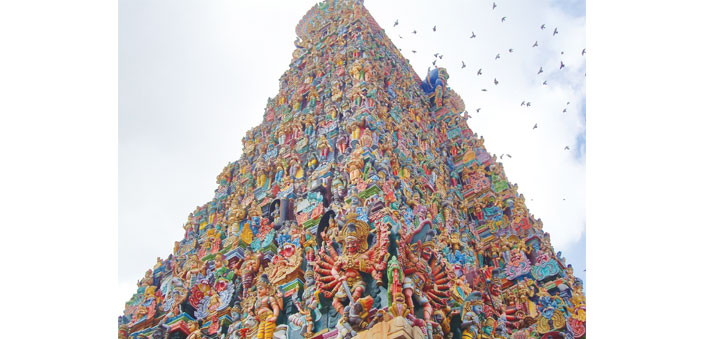Text and photos: Text: Anvi Mehta
Fondly known as the Athens of the South, Madurai is a city with a glorious past. The modern city was established by the Pandya rulers and expanded during the Nayak rule. The city is rich in culture and heritage, and the best way to experience it is by attending a Heritage Walk in the morning.
The streets of Madurai
As Madurai is still a developing city, one can experience a typical south Indian morning here: Men wearing dhotis, pujaris offering prayers, cycle rickshaws carrying bananas, and small cafés brewing filter coffee, are some of the common sights in the old city.The walk typically covers the four Mast streets within which the ancient city thrived. The city area between the inner Mast streets and outer Veli streets is encircled by a fort, and seventy-two fortifications enclosed within four gateways. There are many traces of the ancient city in the modern Madurai which take you back in time.
As mentioned earlier, Madurai is a city with a rich past. The city was the capital of the Pandya rulers since 3rd century B.C. It has a unique place in the literary mentions of the puranas, historical records and accounts of foreigners who visited the city at its glory. Madurai was an important trade centre since its establishment, and it had trade contacts with ancient Greece and Rome. Foreign traders from different sects and religion were associated with Madurai, hence the city’s culture evolved with time. It has been ruled by the Pandyas, Cholas, Sultans, Vijaynagar emperors, Madurai Nayaks, Nawabs of Arcot, and the British.
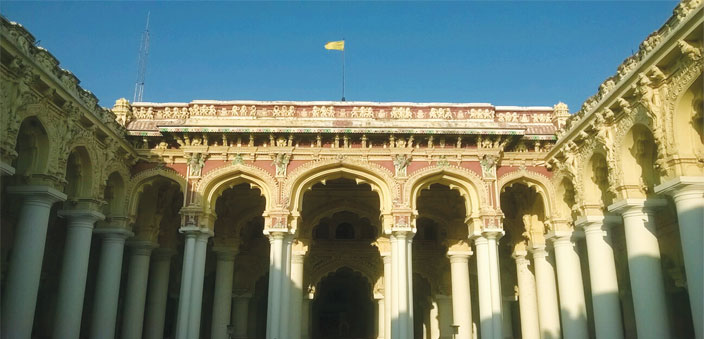
The Thirumalai Nayak Palace
The first stop in the Heritage Walk is the Nayak Palace built by the King Thirumalai Nayak in 1636 A.D. It is a huge palace supported by heavy columns. The palace has beautifully painted domes, striking arches, stucco figures and works which depict the architectural splendour of those times. The palace is an example of Hindu and Muslim architecture combined. The best part of the palace is the Swargavilas, where the King lived. While three-fourths of the palace has been destroyed, the Swargavilas, courtyard, darbar hall, pooja room and bed chamber still exist. A light and sound show is organised in the darbar hall by the tourism department in the evenings. Outside the palace is a small museum where the development of Tamil language is shown via inscriptions and slabs. Although many may not understand the language, the evolution of the script is intriguing.
The Sethupati Hospital
A few hundred meters from the palace is the Sethupati Hospital. It is now an old building in ruins, converted into a departmental store. The structure was erected in 1897 A.D. by the Sethupati ruler of Pamnad in honour of Prince Albert Victor. One can see a stone slab fixed on the wall of this hospital mentioning its construction date and purpose.
The Ten Pillar Lane
A narrow lane to the north of the Nayak Palace has ten stone pillars with a height of 12 meters and a breadth of 1.20 meter. The pillars are the remnants of the Rangavilasa, the second part of the Nayak Palace where the king’s younger brother resided. The lane is known as the Ten Pillar Lane, and is a commercial centre in the modern city. The pillars were assumed to be part of the elephant stables, but historians say that they were part of the Rangavilasa’s darbar hall. Though the tourism department is trying, the pillars need a lot of maintenance.
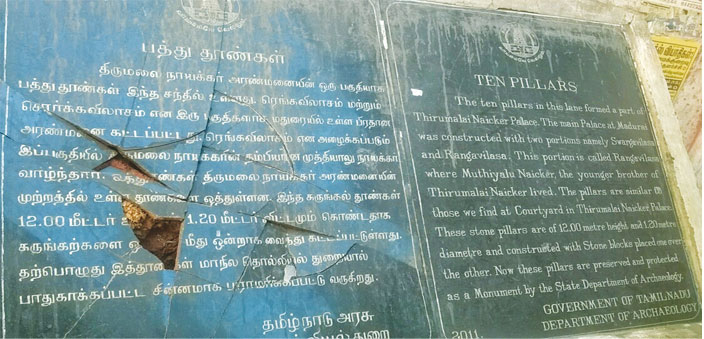
The Vilakkuththun (The lamp post)
The fourth stop in the walk is the lamp post, also known as Vilakkuththun locally. It is situated at the meeting place of South Masi street and the East Masi street, north of the Ten Pillar Lane. The lamp post was installed to honour the then General John Blacburn. Blacburn had ordered the destruction of Madurai Fort and expansion of the city towards the outer streets in 1840 A.D. The lamp post has a British architectural touch to it, and is still lit in the evenings.
The undisturbed gate or Vitthavasal
Vitthavasal, also known as the gate that should be left undisturbed, is the next monument in the heritage walk. Similar to the Pandya Fort, the gate is mentioned in an inscription of the British government found on the gateway. The inscription warns that if anyone tries to harm the gate, they will be severely punished. Currently though, it is kept untouched, the surroundings are crowded, and it is very difficult to actually locate the inscription.
Raya Gopuram
The Nayak kings wanted to build a gopuram which is the largest in the state. They started one in 1654 A.D., and the gopuram was supposed to measure 58 meters in length and 38 meters in breadth and it was located near the Meenakshi Temple, but for some reason, the structure could not be completed and now the incomplete stumbha has a small temple at its base, where prayers are held regularly.
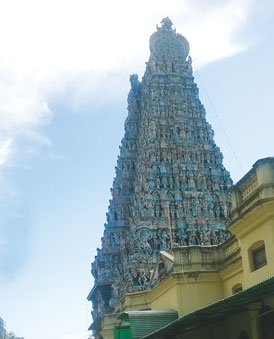
The tank at the Elukadal Street
A lot of history is lost in the development of the modern city. One needs to search for the places which exist, but are camouflaged in the large stores and busy streets. One such monument is a large tank in the Elukadal Street which was broken and converted into a multi-storied commercial complex. A portion of the tank is in the centre of the complex with a temple of Lord Shiva and his consort Goddess Meenakshi. Legend says that Kanchanmala, mother of the Goddess, wanted to take a trip to the seven seas. When Lord Shiva learnt of his mother-in-law’s wish, he miraculously brought the water of the seven seas into this one large tank. An inscription stone near the tank says that an officer of the Vijayanagara ruler renovated and reconstructed the tank in 1516 A.D. He also named it the Saptasakaram.
The Pudumandapam
A hall to celebrate festivals constructed by the Nayak king is currently a market place. While the centre of the hall is locked and opened only during festivities, the fringes have small stores. On the pillars of the mandapam, one can see life-size images of Nayak rulers, the royal family, the Gods and Goddesses. One can see the architecture of that time in the mandapam pillars which also have inscriptions talking about life stories of the Gods and Goddesses. This mandapam defines the structural art of the Nayak period.
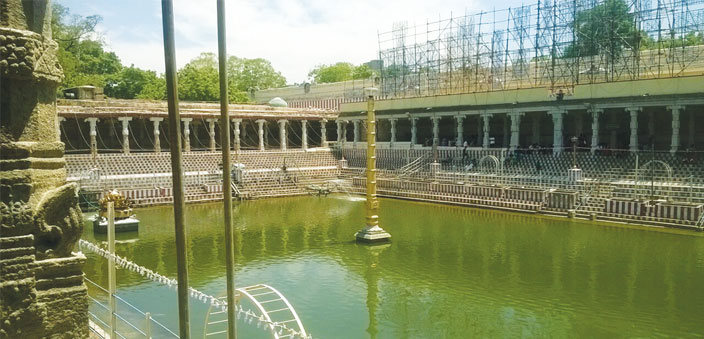
The Meenakshi–Sundaresvara Temple
This ancient temple is one of the major tourist attractions in Madurai. Thousands of pilgrims visit the city every year to offer prayers to Lord Shiva and Goddess Meenakshi. It is said to be a thousand and five hundred years old. The location of the temple is such that it is the center of the city, and the streets of the old city were laid around it. The temple was mentioned in the songs of the holy texts since the Sangam age. It was established and expanded during the rule of early Pandyas. Most of the old structure was removed and reconstructed during the Nayak rule like the gopurams outside the eastern and western gates. The present structure is there since the Nayak rule. The interiors of the temple have scriptural paintings, and there are more than 60 inscriptions which talk about the Nayak and Pandya period. The architecture of the temple show a blend of cultures, as there are elephants, lotuses and dragons all used as motifs on pillars and walls.
Madurai being a city of festivals, the most important one is the Chitra festival. One can see a crowd of lakhs on the street celebrating the Lord and Goddess’ wedding. The hundreds-of-years-old temple cars made from wood and decorated with jewels, are taken around the old streets of the city. If a visit during this time is not possible, one can see the temple cars kept in glass cases on the East Masi street. The temple cars are truly beautiful pieces of art.
A typical heritage walk ends with the Meenakshi Temple, but one can definitely explore the modern city thereafter. The city is very rich in its culture and traditions, one must not leave it without trying its food, especially a cold beverage called jigarthanda.

